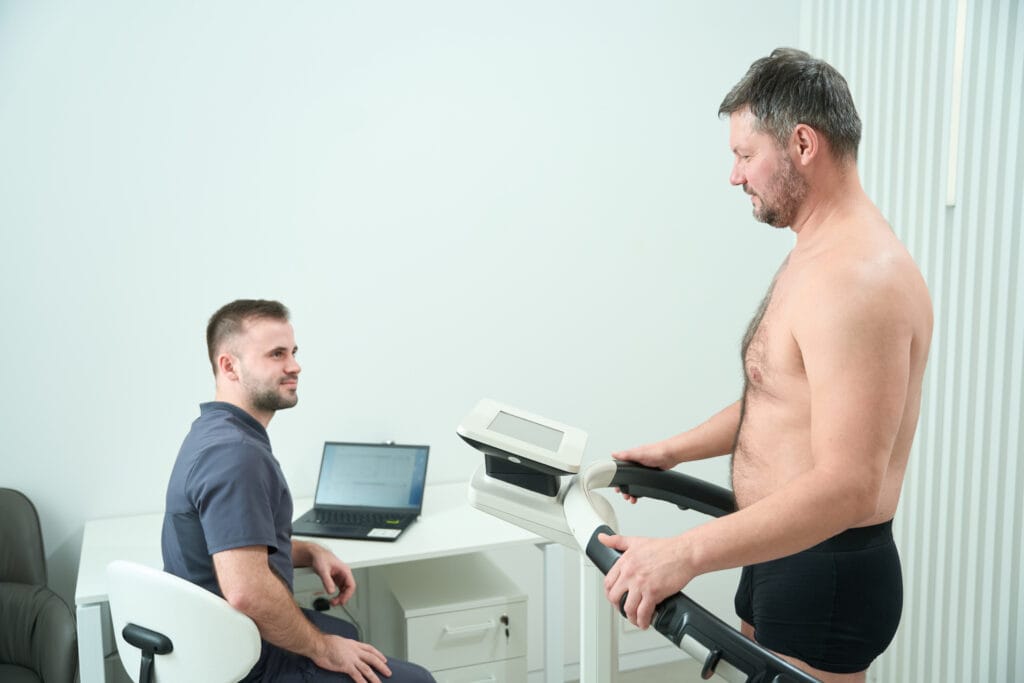
What Is A Healthy Body Fat Percentage?
Your body fat percentage represents the proportion of your total body weight that is composed of fat. This isn’t just about how you look in the mirror, it’s a critical factor in your overall well-being. Having too much or too little body fat can significantly impact your risk for chronic diseases like heart disease, diabetes, and certain cancers. It also plays a key role in hormone regulation, metabolism, immune function, and even your body’s ability to regulate temperature.
In this blog, we’ll dive into the world of body fat percentage, exploring the ideal ranges for men and women, the most accurate way to measure it, and the lifestyle changes that can help you achieve a healthy body composition!
Body Fat 101 - What Exactly Is It?
Body fat percentage isn’t just about the jiggle or extra padding. It’s a precise measurement of how much of your total body weight is made up of fat tissue compared to lean mass, which includes your muscles, bones, organs, and other essential tissues.
Body fat plays a crucial role in numerous bodily functions. Such as:
- Hormone Regulation: Fat tissue produces hormones like leptin and estrogen, which are essential for appetite control, fertility, and bone health.
- Energy Storage: Fat serves as a vital energy reserve, ensuring your body has fuel when required.
- Insulation: Fat helps regulate body temperature and protect your internal organs.
- Vitamin Absorption: Certain vitamins, like A, D, E, and K, are fat soluble and require fat for proper absorption and utilisation.
While some body fat is essential, having too much or too little can be detrimental to your health. Excess body fat (obesity) increases the risk of heart disease, stroke, type 2 diabetes, certain cancers, sleep apnea, and joint problems. It can also lead to inflammation, hormone imbalances, and impaired immune function. Whereas, too little body fat can disrupt hormone production, lead to irregular menstrual cycles in women, weaken bones, compromise immune function, and make it difficult for the body to regulate temperature.
Finding a healthy balance is key. It’s not just about the number on the scale, it’s about achieving a body composition that supports optimal health and well-being.

Ideal Body Fat Percentage Ranges
Understanding your ideal body fat percentage is a crucial step towards achieving a healthy body composition. However, it’s important to remember that there is no one-size-fits-all answer. Several factors influence your ideal range, including your age, sec and activity level.
18-25%
Athletes
Caveats…
Athletes and individuals with high fitness levels typically have lower body fat percentages than the average person. This is due to their increased muscle mass and lower body fat. Additionally, genetics, body type, and other factors can influence your ideal body fat percentage. It’s essential to consider these factors when interpreting these guidelines.
These ranges are not rigid rules. They are a simple guide to help you understand what is generally considered healthy for Australians. The most important thing is to focus on achieving a body composition that supports your overall health and well-being. Don’t get too hung up on hitting a specific number, instead, strive for a balance that feels good for your body.
How To Measure Body Fat Percentage?
Knowing your body fat percentage is one thing, but accurately measuring it is another. Fortunately, there are several methods available, each with its own pros and cons.
Dual-Energy X-Ray Absorptiometry (DEXA Scan)
This medical imaging technique provides a highly detailed analysis of your body composition, including bone density, muscle mass, and fat mass. DEXA scans are considered the most accurate way to measure body fat percentage, but they are expensive and not widely available.
Skinfold Callipers
These handheld tools measure the thickness of skinfolds at various points on your body. The measurements are then plugged into a formula to estimate your body fat percentage. While affordable and portable, this method requires proper technique and can be less accurate than more advanced methods.
Bioelectrical Impedance Analysis (BIA) Scales
These scales send a weak electrical current through your body to measure resistance. Since fat impedes the current more than muscle, the scale can estimate your body fat percentage. BIA scales are convenient and easy to use, but their accuracy can vary depending on factors like hydration levels and recent food intake.
Choosing The Right Method
If you’re looking for the most accurate assessment of your body fat percentage, consider investing in a DEXA scan. However, if you’re on a budget or prefer a more convenient option, skinfold calipers can still provide valuable insights.
Remember, no matter which method you choose, it’s important to be consistent with your measurements and track changes over time to get the most accurate picture of your body composition.
Factors Influencing Body Fat Percentage
While your ideal body fat percentage is a helpful target, it’s important to understand that several factors influence your body composition and how easily you gain or lose fat. These factors can be divided into the following:
- Genetics: Your genes play a significant role in your body type, metabolism, and fat distribution. Some people are genetically predisposed to carry body fat than others.
- Age: As we age, our body composition naturally changes. Muscle mass tends to decrease, and fat mass may increase, even with consistent exercise and healthy eating habits.
- Sex: Men and women have different hormonal profiles, leading to distinct differences in body fat distribution and storage.

Factors You Can Control
Lifestyle
This is where you have the most control. Your daily habits, including diet, exercise, sleep, and stress management, have a major impact on your body fat percentage.
Diet
A diet high in processed foods, added sugars, and unhealthy fats can contribute to excess body fat. Focusing on whole, unprocessed foods, balanced macronutrients, and adequate protein intake can help you maintain a healthy body composition.
Exercise
Regular physical activity, particularly strength training and high-intensity internal training (HIIT), can increase muscle mass and boost metabolism, leading to a lower body fat percentage.
Sleep
Inadequate sleep can disrupt hormone levels, increase cravings for unhealthy foods, and hinder weight loss efforts. Aim for 7-8 hours of quality sleep per night.
Stress
Chronic stress can elevate cortisol levels, which can lead to weight gain and increased fat storage, particularly around the abdomen. Finding healthy ways to manage stress, such as yoga, meditation, or spending time in nature, is essential for maintaining a healthy body composition.
Understanding these factors empowers you to take charge of your health and make informed choices that support your goals. Remember, it’s not just about the number on the scale; it’s about achieving a body composition that makes you feel strong, healthy, and confident.
How To Improve Your Body Composition (Not Just Losing Weight)
Achieving a healthy body fat percentage isn’t solely just about shedding kilos – it’s about transforming your body composition by reducing fat and increasing muscle mass. This holistic approach leads to a healthier, fitter, and more aesthetically pleasing physique. Here’s how you can make it happen:


Unlock Your Health Potential
Your body fat percentage is a powerful indicator of your health and fitness, far more revealing than just your weight. Understanding your ideal range, accurately measuring your body fat, and taking steps to improve your body composition can significantly impact your overall well-being.
If you’re looking for personalised guidance and support on your journey to a healthier body composition, book in a 100% bulk billed initial consultation with My Weight Loss Clinic. Our team of clinicians can help you assess your body fat percentage, create a tailored plan for improvement, and provide ongoing support to help you achieve your goals. Don’t wait – take the first step towards a healthier, fitter you today!
My Weight Loss Clinic
We specialise in education and empowerment. We want this to be the last weight loss program you do.
"*" indicates required fields